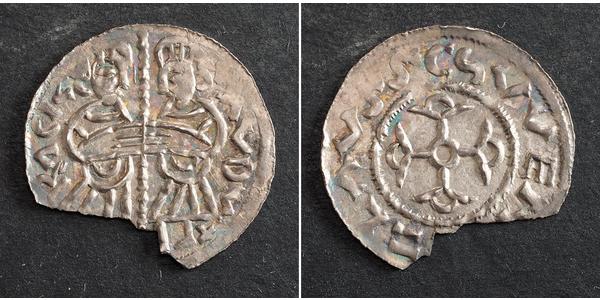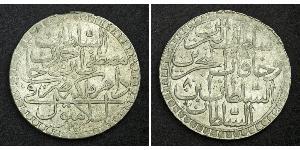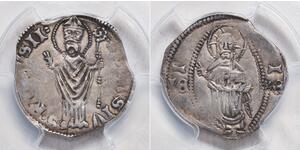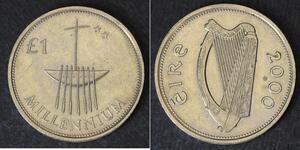(sold for $50.0)
1055, Bohemia (Duchy), Bretislav I. Silver Denar Coin. Chipped/Damaged UNC!
Mint Place: Prague Reference: Cach 312. Denominations: Denar Mint Period: 1037-1055 AD Condition: Damaged (chipped) edge (missing fragments), otherwise a nicely toned UNCirculated! Diameter: 21mm Weight: 0.85gm Material: Silver
Obverse: Two figures standing on either side of long staff. Legend: BRACIZLAV DVX
Reverse: Ornamental cross. Legend: SCS VVENCEZLΛVS
Bretislav I was buried in the old St. Vitus Church in Prague, founded by Wenceslaus I in 930, and his tomb is now situated in the Chapel of St. Wenceslaus in the St. Vitus Cathedral built in the period 1344–66. Bretislav I was depicted in the fresco composition of the Přemyslid dynasty at the Znojmo Rotunda, painted in the period 1134–61.
Bretislav I (Czech: Břetislav I.; 1002/1005 – 10 January 1055), known as the "Bohemian Achilles", of the Přemyslid dynasty, was Duke of Bohemia from 1035 until his death.
Bretislav was the son of Duke Oldřich and his low-born concubine Božena. As an illegitimate son who could not obtain a desirable wife by conventional means, he chose to kidnap Judith of Schweinfurt (Czech: Jitka), a daughter of the Bavarian noble Henry of Schweinfurt, Margrave of Nordgau, in 1019 at Schweinfurt, and marry her.[citation needed]
During his father’s reign, in 1019 or 1029, Bretislav took back Moravia from Poland. About 1031, he invaded Hungary in order to prevent its expansion under king Stephen. The partition of Bohemia between Oldřich and his brother Jaromír in 1034 was probably the reason why Bretislav fled beyond the Bohemian border, only to come back to take the throne after Jaromír’s abdication.
In 1035, Bretislav helped Holy Roman Emperor Conrad II in his war against the Lusatians. In 1039, he invaded Lesser and Greater Poland, captured Poznań, sacked Gniezno, and brought the relics of St. Adalbert, Radim Gaudentius and the Five Brothers back with him. On the way back, he regained part of Silesia, including Wrocław. His main goal was to set up an archbishopric in Prague and create a large state subject only to the Holy Roman Empire. His raid had an unintended enduring influence on Polish history, as the plundering and destruction of Gniezno pushed the next Polish rulers to move their capital to Kraków, which would retain this role for many centuries ahead.
In 1040, the German King Henry III invaded Bohemia, but was forced to retreat after he lost the Battle at Brůdek (a pass in the Bohemian Forest). The following year, Henry III invaded again, skirted the border defences and laid siege to Bretislav in Prague. Forced by a mutiny among his nobles and betrayed by Bishop Šebíř of Prague, Bretislav had to renounce all of his conquests save for Moravia and recognize Henry III as his sovereign. In 1042, Emperor Henry III granted Bretislav Silesia as a lien.
In 1047, Emperor Henry III negotiated a peace treaty between Bretislav and the Poles. This pact worked in Bretislav's favour, as the Polish ruler swore never again to attack Bohemia in return for an annual subsidy to Gniezno.
Bretislav was the author of decrees concerning the rules of Christianization, which included a ban on polygamy and trade on holidays.
It was in 1030 that Bretislav married the afore-mentioned Judith. In 1054, he established rules for the ducal succession and introduced agnatic seniority as the law of succession. Younger members of the dynasty were supposed to govern fiefs (technically, parts of Moravia), but only at the duke's discretion. The result of this succession policy was the relative indivisibility of the Czech lands, but also bitter conflicts over succession and territorial primacy between members of the dynasty. It was effectively ended by the elevation of Bohemia to the status of a kingdom under Ottokar I of Bohemia, which led to the establishment of primogeniture as the ruling principle for succession rights.
Bretislav's eldest son Spytihněv was to succeed him as Duke of Bohemia with control over it domains. Moravia was incorporated into the Bohemian duchy, but divided among three of his younger sons. The Olomouc Appanage went to Vratislaus; the Znojmo Appanage went to Konrád; and the Brno Appanage went to Otto. The youngest son, Jaromír, entered the church and became Bishop of Prague.
Bretislav died at Chrudim in 1055 during preparations for another invasion of Hungary and was succeeded by his son Spytihněv II as Duke of Bohemia. His sons Otto and Vratislav were shut out of the government by Spytihněv, but after his death both gained control of Moravia and Bohemia, respectively.
Only 1$ shipping for each additional coin purchased!

|
Posted by:
anonymous 2021-03-17 |
40 coin descriptions were improved from 2025-05-21 to 2025-05-28
One of them is:
5 Yuan China Silver
group has 2 coins
1 Pound Ireland (1922 - ) Silver
group has 6 coins / 6 prices
⇑
















-300-150-IdLBwcI0cU8AAAEqizBDRaSY.jpg)






